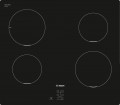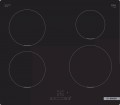Hob material
—
Enamel. The simplest and most common type of coating. Enamel combines low cost and good strength parameters. In addition, it can be produced in almost any colour. On the other hand, cleaning it can require considerable effort, and over time scratches and chips appear on such a surface.
—
Stainless steel. Steel surfaces have a nice appearance. In addition, they are stronger than enamelled ones; cracks and chips do not appear on them. Also, steel is quite easy to clean, but it is difficult to maintain its cleanliness — dirt appears easily, and even fingerprints can ruin a neat appearance. And for cleaning you need to use special tools, otherwise, you can scratch the stove.
—
Glass ceramics. Glass ceramics as a material is generally remarkable for its high thermal conductivity combined with good strength and heat resistance specs.
Schott Ceram and
EuroKera, manufacturers of this very glass ceramics, which manufacturers of household appliances install in their models, were especially successful in this. It made it possible to create original models of electric hobs, where the heating elements are located under a solid glass ceramic surface. The properties of this material allow it to be used with
induction hobs(see below). Such surfaces do not have protruding part
...s, and the location of the heaters is marked only by lines; thanks to this, you can conveniently move the dishes between the heaters, and cleaning such a surface is as simple as possible. However, there are also disadvantages: glass ceramics is less durable than enamel or steel. It requires dishes with a flat bottom, and spilling liquid on a flat surface is fraught with spreading over the entire stove and (not only). Also, this material is used in gas cooking surfaces "gas-on-glass". However, it is rather fashionable because, in addition to strength, it does not have key advantages over a tempered glass (see below) but costs significantly more.
— Tempered glass. The material used in gas-on-glass cooking hobs. it is used to make a surface over which gas burners are located. Such models have an original appearance, and the glass itself is scratch-resistant and can be cleaned well. Its strength and resistance to heat are much lower than that of glass ceramics (in fact, the latter has become the reason that tempered glass is not used in electric hobs), but these moments are more than offset by low cost.
— Cast iron. An original variant found in some premium gas models. The working surface, in this case, is made of the same cast iron as the burner grates, and the grates themselves are protrusions on the cast iron surface. It gives the entire structure an unusual, very strict appearance. And it increases its reliability: the design of the burner grates is such that they will not bend even under the heaviest dishes. On the other hand, cleaning such a surface can be quite laborious, and this option is not cheap. Because of this, there are only a few models with cast-iron surfaces on the market.Burners power
Nominal burners power. It refers to the power consumption of the heater. This parameter allows you to estimate how much electricity the burners will spend when operating at maximum heating intensity. At the same time, the heat transfer power of different burners can be different, and the actual heating efficiency will also greatly depend on the specs of the dishes. As a result, it hardly makes sense to evaluate the working capabilities of the hob by the power of the burners. It is quite possible to proceed from the fact that the burner will be enough for a pot of the same diameter.
Burner diameter
The heating power directly depends on the diameter of the burners. And, at the same time, the performance of the device and the speed of cooking. The larger the burner, the more heat dissipation it has. Also, the diameter of the burner allows you to determine what sizes of dishes are suitable for use on the hob. Indeed, for induction models, this value is critical for high-quality heating. Burners can have the following diameter:
- small — about 145 mm, power within 1200 W;
- medium — about 180 mm, power within 1700 W;
- large — about 220 mm and more, power within 2000 watts.
Some hobs use double ring burners that allow you to adjust the diameter of the heating zone. If the diameter of the burner is 180, 200, 220 mm, then it means that the heating zone on a particular burner can be narrowed or expanded, depending on the size of the dishes used.
Number of power levels
The number of temperature settings of the burner. The more power levels, the more accurately you can set the required temperature for cooking a particular dish. However, in most cases, nine levels are enough for home use. But, if you are a gourmet and often cook unusual dishes that require strict adherence to the recipe, then you simply need more temperature settings.
Functions
—
Auto ignition. An ignition system for gas burners built right into the hob. Most often, auto ignition uses an electric spark, and the device needs to be connected to the mains, even if all the burners on the surface are gas. On the other hand, this function greatly simplifies ignition, eliminating the need for matches, lighters and other sources of the open flame. It is worth saying that auto-ignition systems can work in different ways: in some models, the ignition is triggered immediately when the handle that opens the gas is turned; in others, you need to press a separate button for this.
—
Gas control. A safety system that automatically cuts off the gas supply if the flame is accidentally doused. It consists of two main elements: thermocouples and gas blocking devices. When the flame goes out, the thermocouple sends a signal to the blocking device, which shuts off the gas supply, preventing it from leaking.
—
Temperature probe. A device for measuring the temperature of a dish and determining the degree of its readiness. Such measurements can be carried out both on the surface and in the depth of the product. The core temperature probes usually communicate wirelessly with the hob. Relying on the indicators measured by the temperature probe, the panel automatically regulates the heating or maintains the required water temperature. Also, the temperature pro
...be will be useful when cooking dishes using the sous-vide method.
— Auto switch-off. A system that allows you to automatically turn off the heating if necessary. The principle of operation of the auto switch-off can be different: in some models, it works according to a timer set by the user (see below); in others — when the burner reaches a critical temperature or if the heater has been working for a long time without user intervention. However, this function makes the usage of the hob more convenient and even safer. Note that in gas burners, auto switch-off is rarely found for technical reasons.
— Timer. A device that counts a certain time (set by the user) and gives a signal at the end of the countdown. In addition, the timer can also provide an automatic heating shutdown (see above). The types of timers could be different — from the simplest mechanical knobs to electronic units with displays. The first option is cheaper, but the accuracy is low; electronic devices are more expensive but more accurate and convenient. Anyway, the presence of a timer can significantly simplify the life of the user, relieving him of the need to keep track of time on his own.
— Pause mode. The ability to pause all working burners with one click of the button and then resume their work by pressing the same button. In the pause mode, the burners are turned off and heating continues only due to the residual heat. And when the pause is turned off, all previously set work settings are returned — power, timer countdown, etc. This feature can come in handy when you need to leave the kitchen for a while, and you are not sure how long the absence will last. Note that the pause mode usually has a time limit of several minutes, after which the surface is completely turned off.
— Child lock. The ability to lock the control panel of the device so that turning the knobs and pressing the buttons does not affect its mode of operation (often when the lock is turned on, the knobs are generally fixed). This function is useful primarily as protection against children: a curious baby will not be able to turn on the hob or change its mode of operation at its discretion. The blocking is usually removed in such a way that an adult can do it, but not a child — for example, by pressing the buttons in a certain order.
— Residual heat indicator. The indicator that shows the hotplate is still hot. Usually, it reacts to heating from 50 °C and above. The main function of such an indicator is to prevent burns from touching a burner that has not yet cooled down. It can also be used when turning on the burner — to determine whether it has heated up or not. This feature is especially relevant for solid plate burners (see above), although it can also be useful for Hi-Light burners.
— Built-in hood. The presence of its built-in hood in the design of the hob. Usually, the air intake is located at the level of the burners, its size is small, and the performance is low. Accordingly, a built-in hood is unlikely to be the main ventilation system in the kitchen, but at the same time, it can be a good addition to a separately installed hood. The main disadvantages of hobs with this feature are the high cost and complexity of installation.
— Hob to hood. The ability to control the kitchen hood from the hob. To do this, both devices are synchronized via one or another communication channel; the hood turns on when the burner on the hob is turned on and adjusts the power of work depending on how many burners work and at what power. It eliminates the need for the user to manually turn the hood on and off. And working parameters, usually, are selected in such a way that there is enough power even for the most difficult situations. Some models even allow you to adjust the specific performance of the hood in a given situation. However, it is worth noting that different manufacturers of kitchen appliances use different technologies for communication, differing even in the principle of operation: for example, Miele's Con@Сtivity works by radio, and Electrolux's Hob2Hood works via an infrared channel. Therefore, if you plan to use this function, you should pay special attention to the compatibility of the surface and the hood. It is recommended to choose among devices of the same manufacturer.
— Control via Internet. The ability to control the hob via the Internet. The built-in Wi-Fi module is used to connect to the network. And the control method itself may be different: in some models, you need to install a proprietary application on your smartphone or tablet; in others, it is enough to open a special page in any browser. Nevertheless, this function allows you to control the hob and monitor its status anywhere in the world where the Internet connection is available. Thus, you can, for example, leave the kettle on the burner and turn on the heating in advance on the way home so that hot water is ready by the time you return. And having gone on a long trip, you can at any time check whether you forgot to turn off the hob and, if necessary, turn it off. However, such functionality significantly affects the cost.
